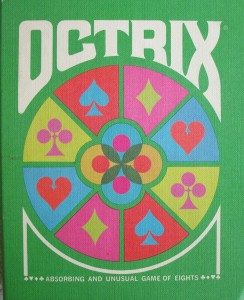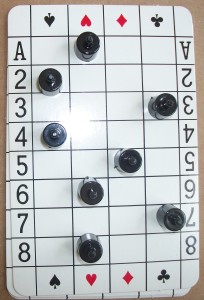 The vintage 1970 game of Octrix is all about ‘eight’ (as the name suggests), and is part of the 3M gamette series. Like the other mini sized games in the set, Octrix comes in a small book-like case. With the titles of the games positioned on the side, like that of a spine of a book, a collection of these make for a neat display to place on either a book or game shelf.
The vintage 1970 game of Octrix is all about ‘eight’ (as the name suggests), and is part of the 3M gamette series. Like the other mini sized games in the set, Octrix comes in a small book-like case. With the titles of the games positioned on the side, like that of a spine of a book, a collection of these make for a neat display to place on either a book or game shelf.
The complete series consists of the following nine titles: Sleuth (1967), High-Bid (1967), Venture (1968), Tryce (1969), Foil (1969), Monad (1969), Octrix (1970), Evade (1971) and Sum-Up (1971).
Any one of these games can be brought down off the shelf for a wonderful and challenging fun time to be had.
Octrix is for 2 to 4 players. The object of the game is to be the first player (or team of 2) to reach 88 points by the scoring of trick taking. Each player receives 8 cards, and so 8 tricks make up a round by players strategically playing their cards one at a time.
An Octrix game consists of 32 standard playing cards from a deck. Only the Ace (low) through 8 (high) cards, in all four suits, are used. The game also includes Octrix boards and posts, and trick taking number cards.
To begin, eight cards are dealt to each of the players. These cards are then ‘posted’ on a player’s Octrix board for all other players to see (a post/marker is positioned on the Octrix board that represents a player’s card from his hand (example shown)).
 Each player then decides on which card might be best played for taking a trick (by looking at the other player’s Octrix boards). He places it face down in the center of the table. After all players have played a card, the cards are turned over to determine who wins the round. The trick will also determine whether the next trick will be taken by high or low card (the first trick is taken by high card).
Each player then decides on which card might be best played for taking a trick (by looking at the other player’s Octrix boards). He places it face down in the center of the table. After all players have played a card, the cards are turned over to determine who wins the round. The trick will also determine whether the next trick will be taken by high or low card (the first trick is taken by high card).
For instance, if 4 players play the following cards on the first round: (2 spades, 5 hearts, 7 diamonds, and 2 clubs), then the 7 of Diamonds (high card) takes the trick. If there was a ‘high’ tie (two people played a 7), then suit rank determines who takes the trick. Suit rank goes as follows: spades, hearts, diamonds, clubs. (a 7 of hearts or spades would have beat the 7 of diamonds).
The next tricks to follow can be taken by either a high or low. This is determined by the highest and lowest cards played in the previous round. If the colors of the highest and lowest card match, high takes the next trick. If they don’t (one heart, one club or something) then low takes the next trick. (in the above example, 2 clubs would take the trick, suit rank low as well for a tie)
After the last trick (the 8th) is finished, scores are tallied. Each trick is worth a point. However, consecutive tricks provide more points for players. The number of tricks taken in sequence is multiplied by itself. So, if a player took tricks 2,3,4, and 7, then his score would be 1 (one point for trick 7), plus 9 (3×3 (3 tricks taken in consecutive order). If a player had taken 1,2,3 and 4, then he would add 16 points, 4×4, for 4 tricks taken in consecutive order. Taking all 8 tricks would give a player a score for the round of 64!
If you do not have an Octrix game, simple graphs for a board, tokens of some kind, and 32 cards from a standard deck can be substituted to play the game. Octrix, like all the other 3M gamettes, is a fun, easy to learn, and quick game to play. Even with so many games to choose from, it is a game we still enjoy to play every now and then.
